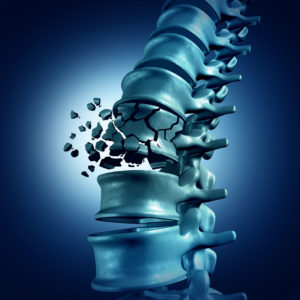Battle of the Bones
More than 53 million Americans are at increased risk for bone fractures. Women have disproportional higher rates of osteoporosis and are at higher risk of developing broken bones than men. Learn more about osteoporosis and how to protect your bones and prevent fractures.

What is osteoporosis?
Osteoporosis literally means ‘porous bones’. It is a medical condition that affects the strength and structure of bones. Bone is a type of tissue in the body that is made of a structural protein, collagen, as well as calcium phosphate, a mineral that adds strength to the bone. More than 99 percent of the body’s calcium is contained in bone. Bone cells are constantly being turned over in the body throughout our lives. Old bone is removed through a process called resorption as new bone is added. New bone is added more quickly than old is removed during out the first 2 decades of life. Once we reach the age of 30, old bone gets resorbed more quickly than new bone is formed, resulting in bone loss. Patients develop osteoporosis when bone replacement occurs too slow or bone resorption occurs too quickly. In patients suffering from this disease, the bones become weaker, increasing the risk of fracture during a fall or even after a minor injury.
What puts us at risk for developing osteoporosis?
Simply being a woman puts us at risk. Although the disease affects both men and women, your chances of developing this disease are much greater if you are a woman. Women have less bone tissue to begin with initially and they also lose bone faster because of hormonal changes after menopause. As we all move through the aging process, our bones naturally become weaker and thinner. Thin-boned individuals or women with small-frames have the highest risk of developing the disease. If your parents have a history of fractures and reduced bone mass, then you may be at risk as well. Osteoporosis does have tend to run in families and genetics does play a role in getting the disease.
Just as there are gender differences in the development of osteoporosis, racial differences also exist. White and Asian-American women are at highest risk of developing the disease whereas African-American and Hispanic women have a lower yet still sizeable risk of osteoporosis.
We have just reviewed factors that place us at higher risk of osteoporosis that we cannot control. There are other risk factors that are within our control. Modifying these factors can reduce our risks of developing osteoporosis. Modifiable risk factors in women include:
-Low estrogen levels, as seen in menopause and eating disorders
-Calcium and Vitamin D deficiencies make us more prone to bone loss
-Medications: Use of some chronic medications such as steroids or anti-seizure medication can result in loss of bone density
-Lifestyle: Inactive lifestyle or prolonged bedrest can weaken bones
-Tobacco use: We always hear about the negative effects of cigarettes on the heart and lungs. They are also bad for the bones….
-Alcohol intake: Research shows that chronic heavy alcohol use, especially during adolescence and young adult life, can increase the risk of osteoporosis later in life.
How do you know if you have it?
Often times, women don’t even realize they suffer from the disease. Osteoporosis is often called a silent disease because bone loss can occur without symptoms until the bones become so weak that a minor strain, bump, or fall can result in a fractured bone. In neurosurgery, we commonly see patients who are initially diagnosed with the disease after they have a collapse in a vertebra, or spine bone.
Knowledge is power! The good news is your doctor can recommend a bone marrow density (BMD) test. The test measures your bone mass and can identify osteoporosis or osteopenia, the precursor to osteoporosis. It’s similar to having an x-ray with much less exposure to radiation. BMD tests measure the bone density in both the hip and the spine. The tests can detect low bone density before a fracture occurs, predict the risk of you breaking a bone in the future, and help monitor your bone’s response to treatments.
How do you treat it?
Osteoporosis treatment is multi-modal in nature and tends to focus on proper nutrition, exercise, safety factors to prevent falls. Treatment may also include various medications to slow bone loss or increase bone strength, thereby reducing the risks of broken bones. It’s best to consult with your doctor to discuss the treatment options that are ideal for you.
Prevention
Fall prevention is a huge necessity in patients suffering from osteoporosis. Falls increase the likelihood of breaking bones in skeleton, especially those in the spine, hips, and wrist. Here are some tips to help reduce environmental factors that may predispose patients to falls:
Outdoors
-Use a cane or walker to increase stability
-Rubber-soled shoes to increase traction
-Be careful of slippery sidewalks and even walking on grass at times
-Carry salt or cat litter with you in the winter to sprinkle on icy sidewalks
-Use plastic or carpet runners if possible.
Indoors
-Maintain clutter free rooms and clear pathways on floors
-Avoid walking in socks, stockings, or slippers
-Walk in shoes that are supportive and have good traction
-Ensure that carpets and area rugs are tacked to the floor or have skid-proof backings
-Make sure that stairwells are well lit and stairs have handrails on both sides
-Install grab bars on bathroom walls near tubs, showers, and toilets
-Use a rubber mat in bathtubs
-Keep a flashlight at your bedside
-Add ceiling fixtures to rooms lit by lamps
-Ensure access to a cordless or cellular phone so you don’t have to rush to answer the phone and so that you may easily call for help in case you do fall
-Consider purchasing a fall alert device
Reference: NIH Osteoporosis and Bone Diseases